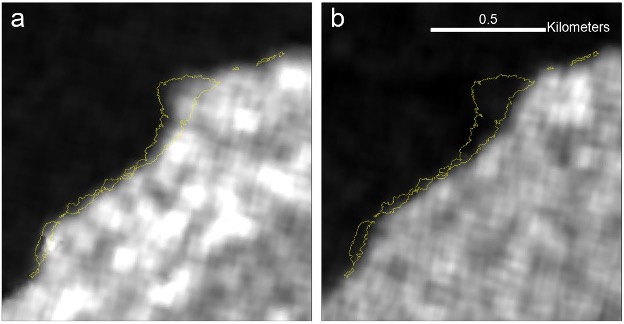
My first project involves the 2014–2015 Holuhraun lava flow-field as an analog for sediment-covered surfaces on Mars. One of the big issues with orbital studies of Mars' surface is the active deposition of sand and dust, which can impair both studies of the composition and morphology of features such as lava flows. Holuhraun is a fitting venue for this kind of study, as it was relatively recently emplaced and has had ample radar coverage since then by ESA's Sentinel-1 mission, allowing us to detect changes in the radar backscatter coefficient, which can tell us if a process like sediment deposition is making the surface of the lava flow-field more "radar dark," meaning smooth relative to the radar wavelength. I've analyzed Sentinel-1 data for the more dry months of the year from 2015 to 2022, and have used this as an input for equations put forth by Campbell et al. (1997) that can determine the amount of regolith needed to attenuate a radar signal based on the "before and after" radar imagery. With this, we can produce estimates of the sand layer thickness that is covering part of the Holuhraun flow. In July 2022, Dr. Shannon Hibbard and I collected ground-penetrating radar data for some of these sediment-mantled sites, and will compare our radar-derived depths to these ground truth datasets in an upcoming publication.

It's only recently coalesced into a coherent topic, but my second project involves a similar attempt to tie orbital data to ground truth measurements. For two months in 2022 I was in the field collecting LiDAR data of various analog sites in the Canadian Arctic and Iceland, and I'm looking at the rock distribution and surface roughness of all of these study sites, with the goal of extracting metrics that can also be gleaned from orbital datasets like radar. In particular, I want to examine the rock distribution of terrestrial analog sites, which can inform strategies for landing spacecraft on the surfaces of other worlds. I have several LiDAR scans of study sites processed and converted to digital elevation models (DEMs), but right now I'm focusing on the best way to extract information on rock distribution from these datasets. Additionally, I want to look into using multiwavelength radar to try and get information about rock abundance and distribution, building off the work of Choe et al. (2020), who looked at tripod LiDAR data of sites in the Canadian Arctic and radar data to compare in terms of surface roughness. I'll be presenting my initial work from this project at a workshop in August, and hope to have some exciting results by then. As far as the rest of my PhD, I have some loose ideas for a third project, but nothing I'm committed to as of yet. Stay tuned!